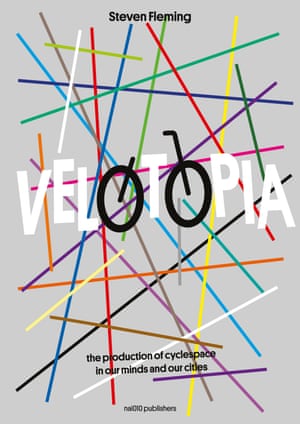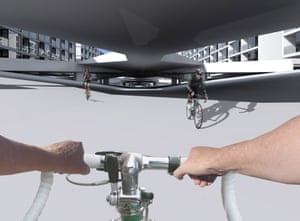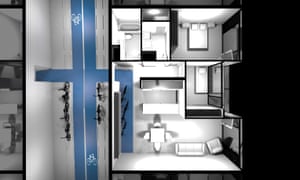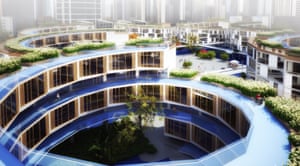Velotopia is as circular as the topography has allowed, for the usual reason that citizens are always clamouring to live near the civic centre.
Development has been restricted to level ground and city limits have been restricted to a diameter of 15km. That ensures average commuting distances of less than 7km and average trip times of less than 30 minutes by bike.
The 15km limits define an area of 177 sq km. Development control guidelines are designed to ensure that at least 30,000 people live in every square kilometre, the average density across Manhattan (including the parks).

No disciples of Le Corbusier, Harvey Corbett, Robert Moses or Norman Bel Geddes have been to Velotopia. That means there are no highways and no racks of car-parking stations. Neither have any disciples of Ebenezer Howard been there to suggest that development be clustered around satellite towns with train connections back to the core.
Velotopia has never sought the services of mobility experts, so has no P&R (park and ride), ERP (electronic road pricing), PRT (personal rapid transport), HOV lanes (high-occupancy vehicle), LRT systems (light rail transit), or anything else that might seem essential because it is described by an acronym. In fact, it is completely car-free. Velotopia has a ground plane where nothing is allowed to threaten or obstruct cycling.
Whenever stakeholder groups are formed for consultation on matters of planning or public life, their constitution requires that the majority be parents of young children. There is no charity or positive discrimination at play here. They simply want to optimise conditions for a group that makes many trips in a day and whose work – raising the next generation – has a great influence on the city’s wealth and productivity in the long term.
Successive committees of parents have voted against a rail network throughout the city. It is sufficient, they have said, to have a few solar-powered electric carts available to collect them at times when they are physically unable to cycle.
Velotopia has a small but efficient fleet of these electric carts.They are limited to 15 kph to ensure they always fall in behind bicycle traffic. Nevertheless, they benefit from the city’s smooth flow. They never have to slow down or stop, so the connectivity speed is much faster.
The city doesn’t need traffic lights as there is no risk of high-speed collisions. Instead there are small roundabouts, raised on elevated mounds. Rising on to the mounds, bikes naturally shed enough speed to safely filter through, before regaining their lost speed as they descend.
There is a major subway station in the centre of the city, covered with ground level shops. Above those is a giant structure for parking thousands of bikes. But trains departing this station don’t leave to other parts of the city. There is no local network. No metro map can be seen on its walls. All of the trains that depart from Velotopia Station are bound for other cities.

Below the pedestrian concourses riders are protected from rain and have been given gravity assistance to get up to speed upon entry. Photograph: Courtesy of cycle-space.com
Dotted around Velotopia, outside city limits, are car parking garages. Visitors coming from car-centric parts of the region park their cars here and swap to one of the four legal modes – cycling, walking, pedicabs or the dynamically-routed driverless carts – to enter the city. Although most Velotopians heading out of the city go on their bikes, some hire cars from these points on the outskirts if they need to go to the country.
With regards to essential services, non-urgent patient transport is done with modified pedicabs and police do patrols using bikes. Cargo bikes are used for deliveries to houses and small shops, and tradespeople, cleaning contractors, gardeners and other groups who can’t prove they need to carry more than 500kg for their work are likewise compelled to use them.
As a result, and even though it is a city of millions, there are never more than a few dozen heavy vehicles moving throughout Velotopia at any one time – not enough to warrant a network of service roads. Successive committees of stakeholders have been very particular about not wanting service roads. People here don’t want to be superficially car-free while cars serve their needs in some behind-the- scenes way. They say that would be like living on Main Street, USA, in Disneyland where visitors are led to believe there are no vehicles, rubbish collections or hurried staff, and that all of the shops are somehow stocked using magic. Disneyland’s deceit is only possible thanks to an underground network of utility corridors.

The people of Velotopia know that garbage trucks collect their bulk waste. They see the cranes and cement mixers that build their new buildings. They are aware that trucks service their supermarkets. It is precisely because motorised vehicles are put in plain view, where they sometimes annoy them, that the people of Velotopia would never vote for a mayor who allowed the ration of motorised vehicles to ever increase.
That leaves fire trucks, ambulances and police cars. These all have 15-kph speed-limiting devices just as the trucks do, but can move at full speed under siren. Emergency vehicles make better time than they would in a city of cars thanks to Velotopia’s compactness and the ease with which cyclists are able to get out of their way.
In Velotopia every commercial premises has a corner location. It is as if one day all the disgruntled shopkeepers lining the avenues had picked up their shops, relocated them part-way along their nearest side streets, then finished their day by quadrupling the number of avenues.
Overall numbers of passers-by are even higher for shopkeepers here than on avenues in Manhattan. That’s because moving in this city is fun. People make more discretionary trips. Half of the time they’re moving through the city for no reason other than to be out. For merchants it’s like having a kiosk in the middle of an ice rink with prospective patrons randomly swirling around them. Every patron has between 10 and 15 seconds to notice their shop, travelling at between 4 and 5 m per second.
From the point of view of citizens riding their bikes, it is a great relief not being herded to avenues and funnelled along them.

This may sound like a difficult city to find your way around, but the ground plane of Velotopia is infinitely varied. Cities with cars may be diverse in their architectural forms and the widths of their streets. Look down, though, and all you will see is the same tired asphalt, curbs and lane markings. In Velotopia there are smooth tracks that attract skaters, dirt tracks with berms and jumps designed for mountain bike riders and more paving treatments than you could fit in a catalogue.
The shops all sit on top of earth mounds so that cyclists naturally slow down as they approach them, and naturally speed up as they ride away. There is a saying here that high means slow, and low means go. High points are where bikes slow to a speed suitable for mingling with pedestrians, while the low spaces between are for bikes to move at cruising speed.
So how do pedestrians move between shops? In parts of Velotopia that have turned out to be busier because of a conglomeration of popular attractions, the preference is for grade separation. Lightweight bridges link the crests of the mounds so pedestrians can walk over while cyclists ride underneath. The few bridges that require them have lifting mechanisms to allow heavy vehicles to pass under. Throughout most of Velotopia, though, cyclists and pedestrians convivially share the same space.
• Dr Steven Fleming is the founder and director of Cycle Space, a consultancy helping cities around the world with bike-centric architecture and urban planning approaches. He can be found on Twitter at @behoovingmoving.
Velotopia is published by nai010 Publishers, who specialise in publishing and distributing books in the field of architecture, urbanism, art, and design. Physical and electronic copies can be ordered from their website.
• What do you think would be necessary in the perfect cycling city? Share your ideas and opinions below the line



